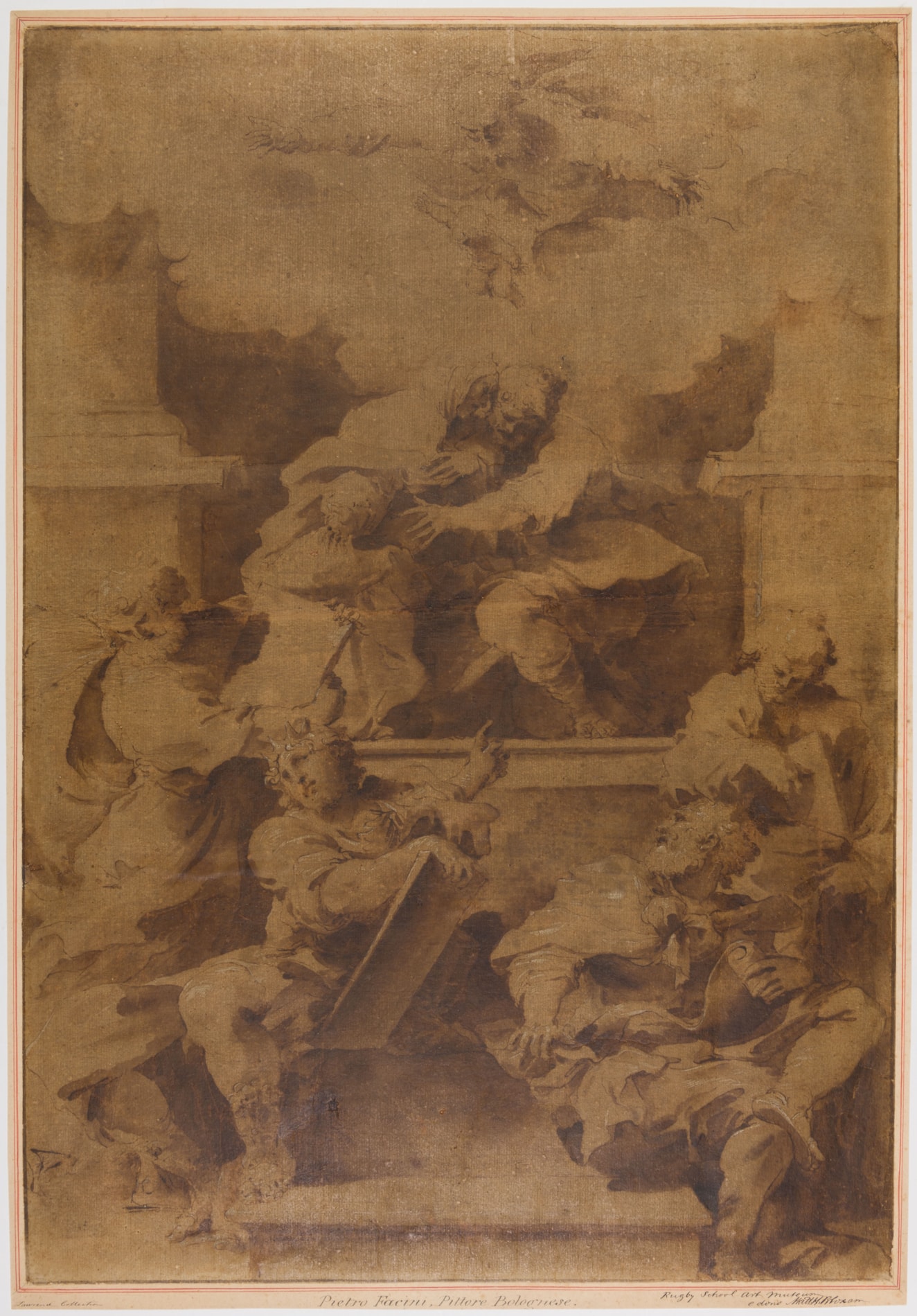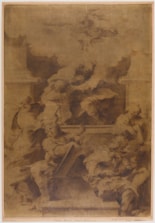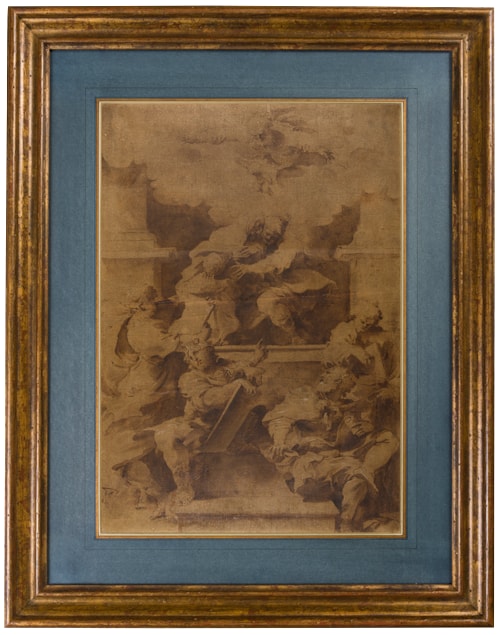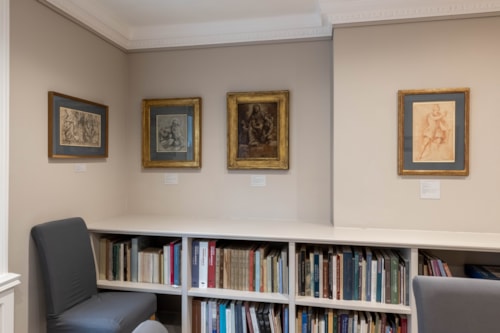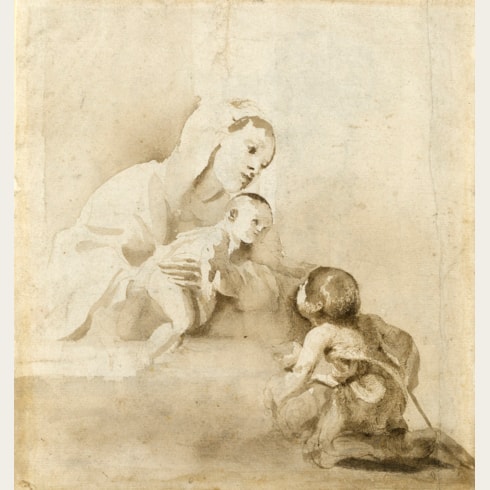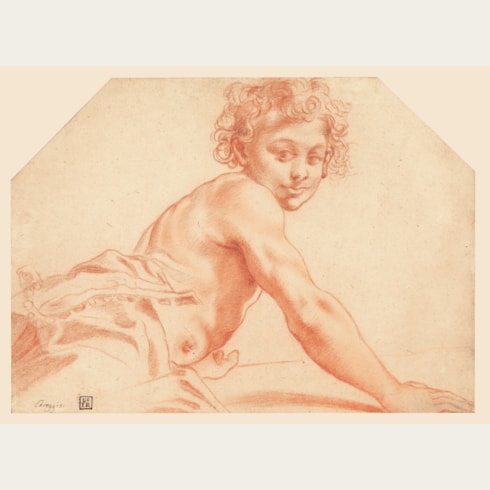Pietro FACCINI
(Bologna 1562 - Bologna 1602)
An Allegory of the Immaculate Conception
Pen and brown ink and brown wash, with touches of white heightening, with framing lines in brown ink, on paper washed brown.
Laid down on a 19th century Ottley mount, with double border lines in red ink.
Inscribed (by Ottley) Pietro Faccini, Pittore Bolognese. on the mount.
Further inscribed Lawrence Collection, and Rugby School Art Museum / e dono Matt: H: Bloxam on the mount.
574 x 397 mm. (22 5/8 x 15 5/8 in.)
Laid down on a 19th century Ottley mount, with double border lines in red ink.
Inscribed (by Ottley) Pietro Faccini, Pittore Bolognese. on the mount.
Further inscribed Lawrence Collection, and Rugby School Art Museum / e dono Matt: H: Bloxam on the mount.
574 x 397 mm. (22 5/8 x 15 5/8 in.)
The scholar Catherine Loisel has described Pietro Faccini as a ‘fascinating artist whose drawings have retained their renown since the 17th century...Faccini distinguishes himself by a kind of exacerbation of effects: floating and expressive figures, an abandonment of anatomical naturalism in favour of a quest for intense emotional impact. His technique is also original, with the exclusive use of the brush or the application of a very greasy black chalk...’ Another scholar, Diane DeGrazia, has noted of Faccini’s drawings that ‘He seems to have worked in many different media during his short working life, sometimes on the same compositions. When working on paper he was certainly more influenced by Venetian colore than were his Emilian contemporaries. He was far more interested in capturing the tones of light and shade in a composition than in understanding the anatomy of the figures. Even in single-figure studies, his powerful forms vibrate with movement in a light-charged atmosphere, making them studies in drama rather than in anatomy...His wide use of a variety of media simultaneously makes it especially difficult to date his sheets and to declare a firm stylistic development.’
The subject of this sizeable and powerful drawing by Faccini would appear to depict the Immaculate Conception, as witnessed by four prophets. In the apocryphal Christian narrative, Saints Joachim and Anne were an elderly married couple, devoted to each other but unhappy because they were childless. An archangel appeared to Anne to tell her that she would bear a child, who would become Queen of Heaven and Earth. The angel instructed her to meet her husband Joachim at the city gate of Jerusalem, and there the two embraced in joy. This moment is also taken to represent the miraculous conception of their daughter, the Virgin Mary, who was born free from original sin.
Faccini was particularly fond of altarpiece compositions on two levels. In the upper register of this drawing is shown the meeting of Joachim and Anna at the Golden Gate, attended by four seated or standing prophets below, while at the apex of the composition God the Father sends the Virgin’s soul or spirit down to her parents. It has been suggested by the Bolognese scholar Michele Danieli that this drawing - one of the largest drawings by the artist to have survived - is Faccini’s modello for an altarpiece in the church of San Giacomo in Bologna, which has been lost since the late 17th century. Although designed by Faccini, the painting is recorded by one 17th century Bolognese writer as the work of his pupil, the obscure Sienese painter Agostino Marcucci, ‘who painted in San Giacomo Maggiore the panel of the altar of the Cantofoli, known as the altar of Saint Anne, where there are some prophets...’ It was not uncommon for Faccini to provide finished drawings for his pupils and assistants to use.
A drawing for the figures in the upper part of the present composition is recorded in a private collection. Among stylistically comparable drawings by Faccini is a Return of the Prodigal Son and an Apollo Flaying Marsyas, both in the Louvre, while an autograph version of the latter composition, also similar in handling, is in the Uffizi.
This impressive but little-known study by Faccini has a distinguished English provenance dating back to the late 18th century. The sheet is laid down on the distinctive mount of the artist, collector, writer and art historian William Young Ottley (1771-1836), who served as Keeper of Prints and Drawings at the British Museum between 1833 and his death three years later. Ottley had spent the years between 1791 and 1799 in Italy, and it was there that he acquired much of his collection of drawings. Some of these were dispersed at four auctions held in London between 1803 and 1814, and the present sheet – with the attribution to Faccini noted by Ottley on his mount – was included in the last and most important of these sales. The drawing then entered the collection of the eminent portrait painter Sir Thomas Lawrence (1769-1830), who may have acquired it at the Ottley sale in 1814, or else in 1823, when he purchased the remainder of Ottley’s collection of Italian drawings en bloc for the sum of £10,000. Lawrence was an obsessive and passionate collector of drawings, and indeed may be said to have assembled the single greatest collection of Old Master drawings ever seen in England. At his death the collection was offered to the King and the British Museum at a price of £18,000, which was probably less than half of what it had cost to put together, but was turned down.
Lawrence’s collection was eventually acquired in 1834 for £16,000 by the art dealer and collector Samuel Woodburn (1753-1853), who offered a large number of them for sale in a series of eight public exhibitions in London in 1835 and 1836. Several years after Woodburn’s death, many of the drawings originally from Lawrence’s collection that were still in his possession were sold by his heirs at auction in London in 1860. The present sheet was one of several drawings purchased at the posthumous Woodburn sale by the antiquary and architectural historian Matthew Holbeche Bloxam (1805-1888), of Rugby in Warwickshire. Bloxam was, in fact, Lawrence’s nephew (his mother was the painter’s sister), and he acquired eight lots, including the present sheet, on the first day of the 1860. Like his father before him, Matthew Bloxam had studied at Rugby School, of which he remained a devoted supporter throughout his life. When the school’s Art Museum opened in 1879, he began donating individual drawings from his collection to the museum on a yearly basis, often on his birthday.
The subject of this sizeable and powerful drawing by Faccini would appear to depict the Immaculate Conception, as witnessed by four prophets. In the apocryphal Christian narrative, Saints Joachim and Anne were an elderly married couple, devoted to each other but unhappy because they were childless. An archangel appeared to Anne to tell her that she would bear a child, who would become Queen of Heaven and Earth. The angel instructed her to meet her husband Joachim at the city gate of Jerusalem, and there the two embraced in joy. This moment is also taken to represent the miraculous conception of their daughter, the Virgin Mary, who was born free from original sin.
Faccini was particularly fond of altarpiece compositions on two levels. In the upper register of this drawing is shown the meeting of Joachim and Anna at the Golden Gate, attended by four seated or standing prophets below, while at the apex of the composition God the Father sends the Virgin’s soul or spirit down to her parents. It has been suggested by the Bolognese scholar Michele Danieli that this drawing - one of the largest drawings by the artist to have survived - is Faccini’s modello for an altarpiece in the church of San Giacomo in Bologna, which has been lost since the late 17th century. Although designed by Faccini, the painting is recorded by one 17th century Bolognese writer as the work of his pupil, the obscure Sienese painter Agostino Marcucci, ‘who painted in San Giacomo Maggiore the panel of the altar of the Cantofoli, known as the altar of Saint Anne, where there are some prophets...’ It was not uncommon for Faccini to provide finished drawings for his pupils and assistants to use.
A drawing for the figures in the upper part of the present composition is recorded in a private collection. Among stylistically comparable drawings by Faccini is a Return of the Prodigal Son and an Apollo Flaying Marsyas, both in the Louvre, while an autograph version of the latter composition, also similar in handling, is in the Uffizi.
This impressive but little-known study by Faccini has a distinguished English provenance dating back to the late 18th century. The sheet is laid down on the distinctive mount of the artist, collector, writer and art historian William Young Ottley (1771-1836), who served as Keeper of Prints and Drawings at the British Museum between 1833 and his death three years later. Ottley had spent the years between 1791 and 1799 in Italy, and it was there that he acquired much of his collection of drawings. Some of these were dispersed at four auctions held in London between 1803 and 1814, and the present sheet – with the attribution to Faccini noted by Ottley on his mount – was included in the last and most important of these sales. The drawing then entered the collection of the eminent portrait painter Sir Thomas Lawrence (1769-1830), who may have acquired it at the Ottley sale in 1814, or else in 1823, when he purchased the remainder of Ottley’s collection of Italian drawings en bloc for the sum of £10,000. Lawrence was an obsessive and passionate collector of drawings, and indeed may be said to have assembled the single greatest collection of Old Master drawings ever seen in England. At his death the collection was offered to the King and the British Museum at a price of £18,000, which was probably less than half of what it had cost to put together, but was turned down.
Lawrence’s collection was eventually acquired in 1834 for £16,000 by the art dealer and collector Samuel Woodburn (1753-1853), who offered a large number of them for sale in a series of eight public exhibitions in London in 1835 and 1836. Several years after Woodburn’s death, many of the drawings originally from Lawrence’s collection that were still in his possession were sold by his heirs at auction in London in 1860. The present sheet was one of several drawings purchased at the posthumous Woodburn sale by the antiquary and architectural historian Matthew Holbeche Bloxam (1805-1888), of Rugby in Warwickshire. Bloxam was, in fact, Lawrence’s nephew (his mother was the painter’s sister), and he acquired eight lots, including the present sheet, on the first day of the 1860. Like his father before him, Matthew Bloxam had studied at Rugby School, of which he remained a devoted supporter throughout his life. When the school’s Art Museum opened in 1879, he began donating individual drawings from his collection to the museum on a yearly basis, often on his birthday.
Pietro Faccini’s brief career seems to have begun at a relatively late age, when around 1583 he entered the Carracci academy in Bologna. His precocious talent is said to have aroused the jealousy of Annibale Carracci, however, and in the 1590’s Faccini left the Carracci academy, later setting up his own school. By this time he was already receiving independent commissions for altarpieces, and indeed the one known dated work by him, an early Martyrdom of Saint Lawrence painted for the Bolognese church of San Giovanni in Monte, was painted in 1590. He may have traveled to Venice, and the influence of Tintoretto noted by his biographer Cesare Malvasia is evident in some of his later works. According to Malvasia, Faccini was a productive painter known for his small-scale decorative pictures, although only a handful of paintings by him survive today. Held in high regard by his contemporaries, he was elected alongside Guido Reni and Francesco Albani as one of the fifteen consiglieri of the Compagnia dei Pittori in Bologna in 1599. One of his last major works was an altarpiece of The Assumption of the Virgin, painted for the church of Santa Maria dei Servi in Bologna. Although strongly influenced by both Annibale and Ludovico Carracci, Faccini developed a fairly idiosyncratic style, and unlike them had few obvious followers.
Aptly described by one scholar as ‘one of the most creative and original draughtsmen of the Emilian school’, Faccini worked in a variety of techniques, using pen and ink wash, red and black chalk, watercolour and oiled charcoal. He was an accomplished and versatile draughtsman, and his drawings were greatly admired for what Malvasia calls their ‘gran spirito’. They were especially popular with collectors, and Cardinal Leopoldo de’ Medici is said to have owned over a hundred drawings by the artist. Guercino also admired Faccini's drawings, which were a strong influence on his early chalk style, and is known to have possessed a number of ‘nudi d’accademia’ by the artist. In fact, Malvasia reserves special praise for Faccini’s drawings of the male nude, which he notes were often confused with those of Annibale Carracci: ‘so many drawings from the nude, that one sees an infinity of his models in all the most famous collections...so sensational, so darting, fluttering, and what is more, so easy and frank, that look as if they were by his master [ie. Annibale Carracci], many are sold every day as if the work of his hand.’ Important groups of drawings by Pietro Faccini, for the most part unpublished, are in the Uffizi, the Louvre, the Kupferstichkabinett in Berlin and the Galleria Estense in Modena.
Provenance
William Young Ottley, London (on his characteristic mount, with his inscription Pietro Faccini, Pittore Bolognese)
His sale, London, T. Philipe, 6-23 June 1814, lot 508 (FACINI (Pietro)…One – a design for an altar picture – pen and bistre, on brown paper, heightened – CAPITAL)
Sir Thomas Lawrence, London (Lugt 2445), his drystamp at the lower left
Purchased after Lawrence’s death, together with the rest of his collection, by Samuel Woodburn, London, in 1834
His posthumous sale (The Valuable and Important Collection of Drawings, By the Old Masters, Formerly in the Collection of the Late Sir Thomas Lawrence, P.R.A., And more recently the Property of that Distinguished Connoisseur, Samuel Woodburn Esq., Deceased), London, Christie’s, 4-8 June 1860, part of lot 15 (The seizure of Christ, BASSANO; a scriptural subject, FACCINI; death of a saint, P. TESTA. &c., bt. Bloxam for 15 gns.)
Matthew H. Bloxam, Rugby, Warwickshire
Presented by him to Rugby School, Rugby, Warwickshire, probably between 1879 and 1888.
His sale, London, T. Philipe, 6-23 June 1814, lot 508 (FACINI (Pietro)…One – a design for an altar picture – pen and bistre, on brown paper, heightened – CAPITAL)
Sir Thomas Lawrence, London (Lugt 2445), his drystamp at the lower left
Purchased after Lawrence’s death, together with the rest of his collection, by Samuel Woodburn, London, in 1834
His posthumous sale (The Valuable and Important Collection of Drawings, By the Old Masters, Formerly in the Collection of the Late Sir Thomas Lawrence, P.R.A., And more recently the Property of that Distinguished Connoisseur, Samuel Woodburn Esq., Deceased), London, Christie’s, 4-8 June 1860, part of lot 15 (The seizure of Christ, BASSANO; a scriptural subject, FACCINI; death of a saint, P. TESTA. &c., bt. Bloxam for 15 gns.)
Matthew H. Bloxam, Rugby, Warwickshire
Presented by him to Rugby School, Rugby, Warwickshire, probably between 1879 and 1888.
Literature
Elizabeth Llewellyn and Cristiana Romalli, Drawing in Bologna 1500-1600, exhibition catalogue, London, 1992, unpaginated, no.28.
Exhibition
London, Courtauld Institute Galleries, Drawing in Bologna 1500-1600, 1992, no.28.

